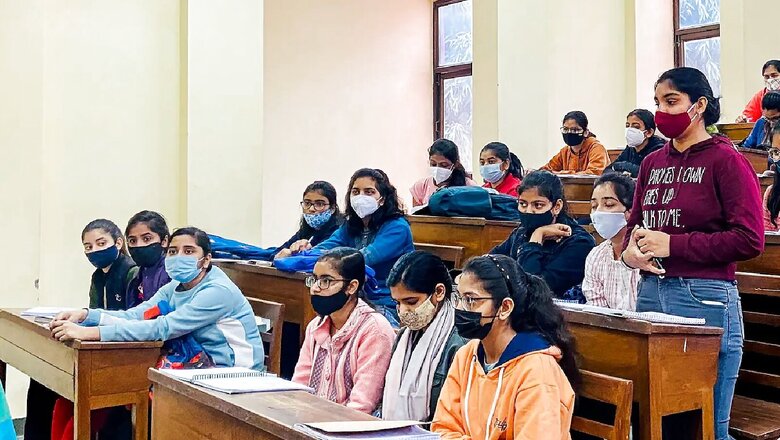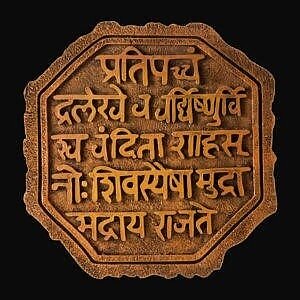
views
We all remember Chhatrapati Shivaji Maharaj (henceforth Shivaji) as the fearless Hindu warrior he was, the one who stood like a rock against Islamic marauders and plunderers, for establishing self-rule in India’s heartland and uniting people from all tribes and clans under the banner of Hindavi Swarajya.
To set the record straight, there’s more to Shivaji than the saffron, sword, and moustache, which the so-called ‘righteousness’ failed to identify for themselves, let alone educate their offspring. One such truth is Shivaji’s profound and prolific love of language, literature, and culture. According to history, Shivaji placed a high value on the use of language in his administration and kingdom, believing that a language brings with it its own distinct thought process and culture. There isn’t much swarajya if the establishment doesn’t have its own language (literally self-rule). Scholars of swarajya were tasked with creating Rajya Vyavahar Kosh, a vocabulary of roughly 1400 words to be utilised in day-to-day governance. This was done to ensure that Marathi terminology derived from Sanskrit replaced the prevalent Arabic-Persian jargon in the administration. This should be a clincher for any political or bureaucratic regime because most of them are still unaware that despite all the bravado and brouhaha made by Marxist historians, Shivaji, with his wonderful model of administration and reforms, is still in the docks of history. The age of Indian administration imbued with indigenous values and ethos in vernacular is yet to find its place in the administrative and educational rungs.
Ironically, the post-independence system of governance and polity saw our indigenous languages, customs, and way of life sacrificed on the altar of politics. Even in their own states, Indian languages did not make the necessary growth. English has maintained its dominance as the language of the state machinery at all levels. Rich languages such as Hindi, Assamese, Tamil, Telugu, Kannada, Gujarati, and others could not become the language of governance and administration even inside the state boundaries due to the overvaluation of English and the false pride associated with knowing and speaking it.
Notwithstanding the considerable weight that Gandhiji set on the use of Hindi for the country’s official activities, the language failed to emerge from the restrictions of the ‘Hindi Week’ observed once a year. And, as luck would have it, India’s first prime minister was only fully comfortable speaking English. Throughout his life, and especially during his stint as the prime minister, he spoke, lived, and breathed English. This is one of the reasons I believe English has become an integral component of our policies and conversation.
To be fair, in India, political independence was never accompanied with the ability to choose our own system of governance and administration. It does not amuse me that the departments of administration, police, finance, law, education, and so on have stayed largely unchanged since the British period. The administration’s language and attitude are identical to those of its colonial predecessor. The language that the British left behind, which is after all a foreign language, has continued to rule the roost. Hindi and its sister languages should have fought tooth and nail with English before splitting up, as a result of which the language became acceptable as the sole lingua franca. The state that emerged after 1947 lacked its own language, which has become one of its major flaws. Instead of simple and easy-to-understand words, Hindi was burdened with complicated words and phrases, mocking the language itself, which was exactly what the ruling elite desired. There is a self-proclaimed progressive sector of society that despises the restoration of ancient and glorious names of locations and cities. Surprisingly, according to Indian language science, a name is a set of syllables, and each syllable signifies the ‘Supreme One.’ As a result, good word usage is essential! Any self-respecting culture and people must restore the original names of towns and cities that were modified by enslavers and imperialist powers.
This is not an article about Shivaji and his policies. Not completely. Since its genesis in the good old days when its draught was disclosed and up to its current pronouncement, there has been a lot of hullabaloo by intellectuals with left leanings. In the guise of professing liberalism, progressiveness, and secularism, per se, self-proclaimed crusaders of the cause, literary festival champions, and the wine-sipping intelligentsia mistakenly omitted the fact that the curriculum so adopted must include basic arts, crafts, humanities, languages, literature, culture, and values, in addition to science and mathematics, to unleash all the aspects and capabilities of a learner and make education about Indian knowledge and its diverse social, cultural, and technological needs, as well as its unparalleled artistic, language, and knowledge traditions. Strong ethics in India’s youth is regarded as critical for instilling national pride, self-confidence, self-knowledge, cooperation, and integration.
According to NEP 2020, “the central principles guiding both the education system as a whole and individual institution within it include promoting multilingualism and the power of language in teaching and learning; extensive use of technology in teaching and learning, removing language barriers, increasing access for physically challenged students, and educational planning and management; respect for diversity and respect for the local context in all curriculum, pedagogy, and educational planning and management.” The new policy also “envisions an education system rooted in Indian ethos that directly contributes to transforming India, that is Bharat, sustainably into an equitable and vibrant knowledge society by providing high-quality education to all, thereby transforming India into a global knowledge superpower.”
Today, we must resurrect our cultural values, languages, and literature and firmly establish them in our governance and administration, as Shivaji did in his day. That is where the New Education Policy 2020 comes in. A country’s education strategy is the catalyst for innovation and inventiveness. Consider Germany, which has entered a new phase in recent decades. Their 1949 Basic Law provides every German citizen with the right to self-actualisation. Citizens, in other words, have the ability to select the type of education they desire and have access to their preferred occupation or profession in their regional and local languages. Thus, the purpose of educational policy is to give chances to each citizen to grow personally, professionally, and as a citizen in accordance with his or her strengths and preferences. The outcomes are self-explanatory to the rest of the globe.
The Shivaji Royal Seal

Yuvraj Pokharna is an independent journalist and columnist. He tweets with @pokharnaprince. Views expressed are personal.
Read all the Latest Opinions here


















Comments
0 comment